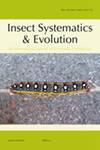在澳大利亚首次记录到弗格森虫(双翅目:弗格森虫科)和其伴生的弗格森虫(虻目:新虻科)在细尾蕨(桃蚜科)上形成瘿,并有新种描述
IF 1.3
3区 农林科学
Q2 ENTOMOLOGY
引用次数: 2
摘要
一种来自昆士兰北部Leptispermum madidum A.R.Bean的苍蝇新种Fergusonia madidum Taylor sp.n(直翅目:Fergusonidae)和一种来自L.laevigatum(Gaertn.)F.Muell的线虫新种Fergusobia Leptospermum Davies sp.n。描述了澳大利亚维多利亚州南部。这些代表了从细子植物属(Myrtacee)中描述的Fergusonia蝇/Fergusobia线虫互惠共生的第一个物种。Fergusonia madidum sp.n形成侧生和顶生的多房芽芽鞘,包围在顶生小叶中。它与所有其他Fergusonina物种的区别在于雌性腹部第7节缺乏背刚毛。与大多数描述的Fergusonina物种不同,它的翅膀也缺乏后交叉静脉m-cu。它与来自伞菌属花蕾galls的F.giblidavisi Taylor和F.thomasi Taylor有着共同的特征,但这两个物种都很大,雌性的腹部第7节密被刚毛。其幼虫尚不清楚,但从蛹的形态来看,背盾由3条宽的横带组成,横带由侧行隆起的脊状硬化针状物组成。与其相关的线虫种类尚不清楚。细精Fergusobia leptospermum sp.n与隐蔽的侧生和顶生的通常为单眼芽芽的菌毛有关。其特征是开放到紧密的C形单性生殖雌性具有较小的“a”比,具有短但坚固的探针,前端平坦;巨大的咽背腺,生殖系统有一个相对较长的子宫,一个近圆锥形的尾巴,顶端宽而圆;C形感染性雌性,尾部几乎呈半球形,腹部可能有钩,也可能没有钩;和一只开放的C形雄性,前端附近有棱角分明的针状物和盆腔囊,以及一条相对较长(C'=2.2-3.2)的亚圆锥形尾巴,尖端钝到宽圆形。分子分析证实了它作为一个独特物种的地位。与其相关的苍蝇种类仅从几个幼虫和一个蛹中得知,目前尚未描述。这种Fergusonina物种的背盾由7条宽带组成,前6条具有严重硬化的隆起脊,第7条具有弱骨针的内侧区。广泛分布的采集地点,加上细精植物中的大量物种,表明互惠共生很可能是物种性的,并在该宿主上占据广泛的地理范围。本文章由计算机程序翻译,如有差异,请以英文原文为准。
First record of Fergusonina (Diptera: Fergusoninidae) and associated Fergusobia (Tylenchida: Neotylenchidae) forming galls on Leptospermum (Myrtaceae) in Australia, with descriptions of new species
A new species of fly, Fergusonina madidum Taylor sp.n. (Diptera: Fergusoninidae) from Leptospermum madidum A.R. Bean in far north Queensland and a new species of nematode, Fergusobia leptospermum Davies sp.n. (Tylenchida: Neotylenchidae) from L. laevigatum (Gaertn.) F. Muell. in southern Victoria, Australia are described. These represent the first species of the Fergusonina fly/ Fergusobia nematode mutualism to be described from the genus Leptospermum (Myrtaceae). Fergusonina madidum sp.n. forms lateral and terminal multilocular shoot bud galls enclosed in subterminal leaflets. It can be distinguished from all other species of Fergusonina by the lack of dorsal setae on abdominal segment 7 of the female. Unlike most described species of Fergusonina it also lacks the posterior cross vein m-cu in the wing. It shares this character with F. giblindavisi Taylor and F. thomasi Taylor from flower bud galls on Corymbia , but both these species are large and abdominal segment 7 of females is densely setose. Its larva is unknown but from the morphology of puparia the dorsal shield comprises 3 broad transverse bands comprising lateral rows of raised ridge-like sclerotised spicules. Its associated species of nematode is not known. Fergusobia leptospermum sp.n. is associated with cryptic lateral and terminal usually unilocular shoot bud galls. It is characterised by the combination of an open to tight C-shaped parthenogenetic female having a small ‘a’ ratio, with a short but sturdy stylet, flat anterior end; huge dorsal pharyngeal gland, reproductive system with a relatively long uterus, and a sub-conoid tail with a broadly rounded tip; a C-shaped infective female with an almost hemispherical tail tip which may or may not be ventrally hooked; and an open C-shaped male with angular spicules and peloderan bursa arising near the anterior end, and a relatively long (c’ = 2.2–3.2) sub-conoid tail with a bluntly to broadly rounded tip. Its status as a distinct species is confirmed by molecular analyses. Its associated species of fly is known only from several larvae and a puparium, and remains undescribed. The dorsal shield of this Fergusonina species comprises 7 broad bands, the first six having heavily sclerotised raised ridges and the seventh with a medial field of weak spicules. The widely separated collection localities, together with the large number of species in Leptospermum suggest that the mutualism is likely to be speciose and occupy a broad geographic range on this host.
求助全文
通过发布文献求助,成功后即可免费获取论文全文。
去求助
来源期刊

Insect Systematics & Evolution
生物-进化生物学
CiteScore
3.00
自引率
0.00%
发文量
15
审稿时长
>12 weeks
期刊介绍:
Insect Systematics & Evolution (ISE) publishes original papers on all aspects of systematic entomology and the evolutionary history of both extant and extinct insects and related groups. Priority is given to taxonomic revisions and phylogenetic studies employing morphological and molecular data. ISE also welcomes reviews and syntheses that can appeal to a wide community of systematic entomologists. Single species descriptions, regional checklists, and phylogenetic studies based on few taxa or single molecular markers will generally not be accepted.
 求助内容:
求助内容: 应助结果提醒方式:
应助结果提醒方式:


